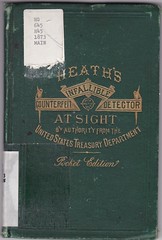
PREV ARTICLE
NEXT ARTICLE
FULL ISSUE
PREV FULL ISSUE
BOOK REVIEW: HEATH’S COUNTERFEIT DETECTOR, 11TH EDITION
Michael E. Marotta submitted this review of the 1873 eleventh edition of the classic Heath’s Counterfeit Detector. Thanks!
-Editor
“Having had unlimited experience in the detection of counterfeit and altered bank-notes, I felt the necessity of placing this knowledge within the reach of all; consequently, in June 1864, I published the first edition of “Heath’s Counterfeit Detector,” which met with such favor from the public that it reached the enormous sale of twenty-five thousand copies, and would have far exceeded this number had not the whole currency of the country been changed to what is commonly known as greenbacks, and national bank-bills.” – Introduction. Laban Heath obtained permissions and material support from the U.S. Treasury as well as from the private firms: National Bank Note Co. of New York and Boston, the American Bank Note Company of New York, and the Continental Bank Note Company of New York.


“The success of counterfeiters in circulating their spurious issues is not at all due to any excellence of work that would deceive a practiced eye, but to the general ignorance of the public as to what constitutes good and poor engraving.” Heath’s of course was but one of several serving the same purpose. Providing an overview for The Asylum (Volume II Number 1), Kirby W. Brown wrote: “Common to all of these publications is division of the text into “rules” for detecting counterfeits. For example, Eastman's 1859 work is divided into 10 principle rules: Geometrical lathe work; parallel ruling (ruling engine); medallion ruling or engraving; perspective (appearance); vignettes; printing; lettering; ink; engraver's Imprint; and signatures.” Indeed, the Introduction to Heath’s enumerates five: Geometrical Lathe Work, Ruling Engine Work, Vignettes, Solid Print, and Minor Rules. Each of them is the title of a subhead. Heath also sold a microscope for inspecting notes. According to the description in this book, the device could be reconfigured as a magnifier, microscope, or telescope. Made in Paris, it sold for five dollars. The little book is a delightful read. I have been through it twice; and both times coming to the last word was like having to leave a party.
Why should book reviews be restricted to new ones? Reader thoughts on other useful out-of-print numismatic books would be most welcome. Who will write the next one?
-Editor
To view the NBS Wiki bibliography page on Heath's, see:
Heath’s Infallible Counterfeit Detector
(wiki.coinbooks.org/index.php/HEATH%E2%80%

Wayne Homren, Editor The Numismatic Bibliomania Society is a non-profit organization promoting numismatic literature. See our web site at coinbooks.org. To submit items for publication in The E-Sylum, write to the Editor at this address: whomren@gmail.com To subscribe go to: https://my.binhost.com/lists/listinfo/esylum All Rights Reserved. NBS Home Page Contact the NBS webmaster 
|
